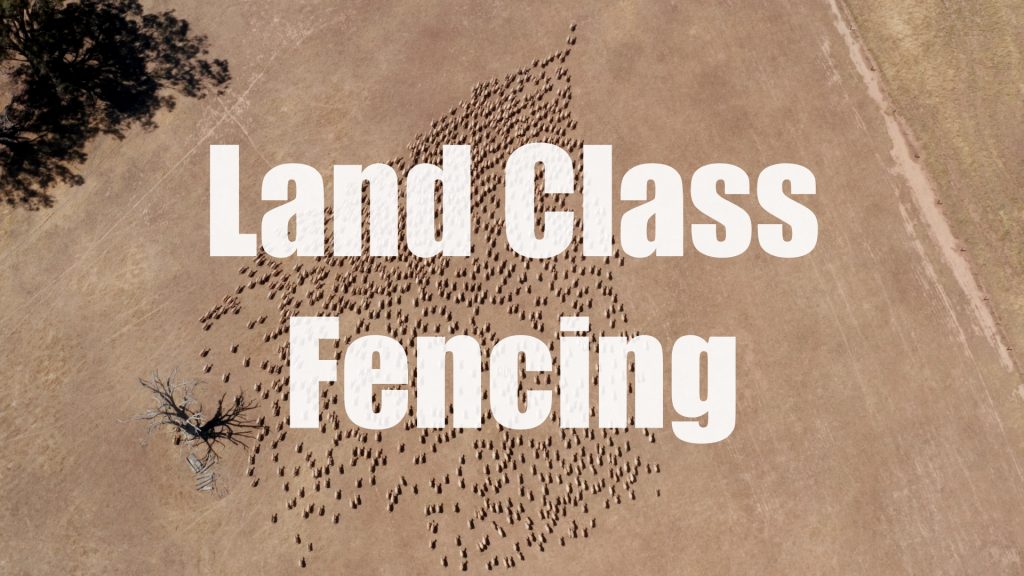Figuring out the best way to manage your land can be overwhelming. There are so many different systems, methods and philosophies on how to increase outputs and minimise inputs. Unfortunately there’s no one size fits all approach. Every property is different. Every season is different. Every business is different.

There are however some aspects of each property that remain relatively consistent with time. It’s these aspects that Land Class Fencing uses at its core.
Land Class Fencing allows you to assess your property’s unique characteristics and divide it up into areas of similar output and resilience. These areas are converted to paddocks, which can then be managed in the same way as other paddocks of the same class.
Some of the characteristics that can be used to divide your land into classes include:
- Slope
- What’s the pitch of the area? Is is slightly undulating or extremely steep? Sheep prefer to camp at the top of hills.
- Direction
- Is the area North facing, therefore catching more sunlight than a South facing slope?
- Ground cover
- How much and what kinds of vegetation are present? This can include trees, weeds and grasses. Generally, the more ground cover there is, the more the area is resilient to erosion and less prone to flooding.
- Soil type and characteristics
- Does the soil have a high carbon content? Is it mostly clay, loam or sand? Does it absorb and retain moisture? Is it compacted from years of stocking?
- Accessibility
- Can you access the land with a tractor? Can it be seeded or fertilised?
- Access to water
- Is there a consistent source of water for livestock? Does it dry up in summer? If there’s no water source in your proposed paddock, you’ll need to factor in the cost of adding a dam or trough.
By carefully observing your land and thinking about each of these characteristics, you can begin to get a feel for each area. From this, you can start to plan fence lines and create a budget.

The land should be roughly divided up into each area’s potential output. For instance, flat, well drained country is likely the most productive land, suitable for grazing or cropping. It’s less prone to damage from livestock and machinery, and easier to work than steep hills. Steep hills require more careful grazing, and may not be easily accessible with machinery. Undulating country will often be quite productive, but with higher variability than flat country. This is probably not suitable for some types of crops, but it’s still ok for grazing.
It’s recommended that you first use electric fences for your new paddock boundaries. The reason is that you want to test that your fencelines are going to achieve the desired result before you commit the time and expense to a full, permanent fence. Only when you’ve proven that your classes are sound and you’re seeing the desired result should you commit to new fences. Fences should be installed at the break of slopes (where the angle of the ground begins to change). Putting fences along ridgelines is not advised, as stock will congregate at the ridge.
Fences are only half the battle though. Once the infrastructure is in place it’s time to consider the other factors.
Rotational grazing is essential to maximising your productivity whilst preserving your land. Grasses don’t like to be continually grazed, as it limits their recovery time. The issue with small mobs/herds in large paddocks is that the livestock will preferentially graze certain areas over others. This leads to over and undergrazing within the same paddock. Once you’ve created smaller paddocks, increasing your mob/herd size is essential for effective management of your grasses. This is because it allows more control of how each paddock is grazed. With careful monitoring, livestock can be moved on to the next paddock when the grass is optimally grazed. Preventing overgrazing has several benefits, including higher long term productivity and less chance of erosion.

So to summarise, the general steps of Land Class Fencing are:
- Carefully observe your land before making any changes.
- Use electric fences first to test your new paddock boundaries.
- Once you’re happy with the proposed fence locations, plan and install your new fences and water infrastructure if required.
- Increase the size of your mobs/herds for more control and efficiency.
- Watch your grasses and use rotational grazing to continually move livestock through the farm.
- Allow land time to rest and avoid grazing sensitive or vulnerable areas.
If you’d like to find out more about managing your property, the Healthy Hectares guide is packed full of useful advice. While you’re at it, check out our other video on Hillside Erosion.

